Some of the referenced valuation measures is Dr. Robert Shiller’s Cyclically Adjusted Value-Earnings Ratio, generally known as CAPE. Valuations have at all times been, and stay, a necessary variable in long-term investing returns. Or, as Warren Buffett as soon as quipped:
“Value Is What You Pay. Worth Is What You Get.”
One of many hallmarks of very late-stage bull market cycles is the inevitable bashing of long-term valuation metrics. Within the late 90s, should you had been shopping for shares of Berkshire Hathaway (NYSE:), it was mocked as “driving Dad’s previous Pontiac.” In 2007, valuation metrics had been dismissed as a result of the markets had been flush with liquidity, low rates of interest, and “Subprime was contained.”
In the present day, we once more see repeated arguments about why “this time is totally different” due to ongoing beliefs that the Fed will bail out markets if one thing goes flawed. In fact, it’s arduous in charge traders for feeling this fashion, because it has repeatedly occurred for the reason that “Monetary Disaster.”
There’s little argument, and as proven, present trailing valuations are elevated.
Nonetheless, we have to perceive two essential factors about valuations.
Valuations usually are not a catalyst of imply reversions, and;
They’re a horrible market timing device.
Moreover, traders typically overlook essentially the most important elements of valuations.
Valuations are glorious predictors of return on 10 and 20-year intervals, and;
They’re the gas for imply reverting occasions.
Critics argue that valuations have been excessive for fairly a while, and a market reversion hasn’t occurred. Nonetheless, to our level above, valuation fashions usually are not “market timing indicators.” The overwhelming majority of analysts assume that if a measure of valuation (P/E, P/S, P/B, and so forth.) reaches some particular degree, it signifies that:
The market is about to crash, and;
Traders must be in 100% money.
That is incorrect.
Valuations Replicate Sentiment
Valuation measures are simply that—a measure of present valuation. Furthermore, valuations are a significantly better measure of “investor psychology” and a manifestation of the “larger idiot idea.” This is the reason a excessive correlation exists between one-year trailing valuations and client confidence in greater inventory costs.
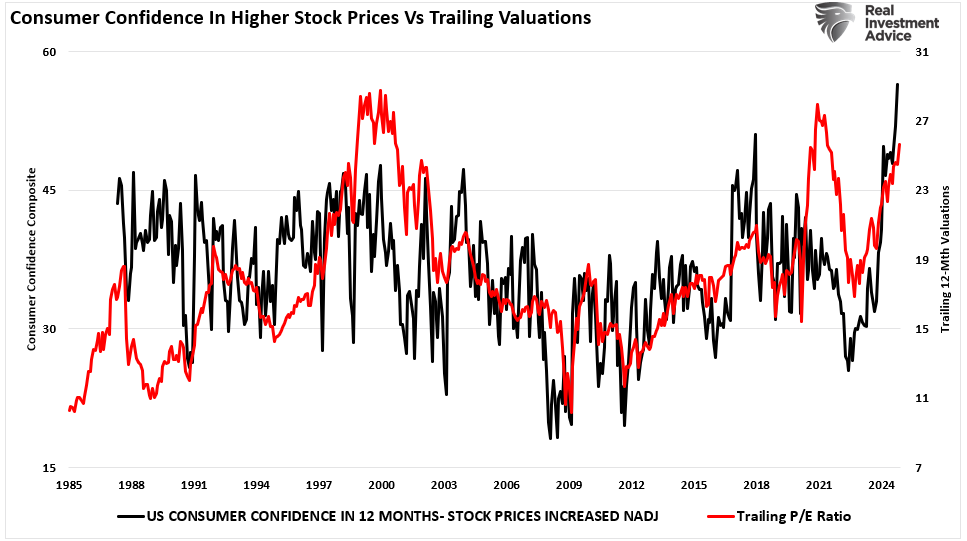
What valuations do categorical must be apparent. Should you “overpay” for one thing at present, the long run internet return will likely be decrease than should you had paid a reduction for it.
Cliff Asness of AQR beforehand mentioned this concern:
“Ten-year ahead common returns fall practically monotonically as beginning Shiller P/E’s enhance. Additionally, as beginning Shiller P/E’s go up, worst circumstances worsen and finest circumstances get weaker.
If at present’s Shiller P/E is 22.2, and your long-term plan requires a ten% nominal (or with at present’s inflation about 7-8% actual) return on the inventory market, you might be mainly rooting for the very best case in historical past to play out once more, and rooting for one thing drastically above the common case from these valuations.”
We will show that by ahead 10-year complete returns versus numerous ranges of PE ratios traditionally.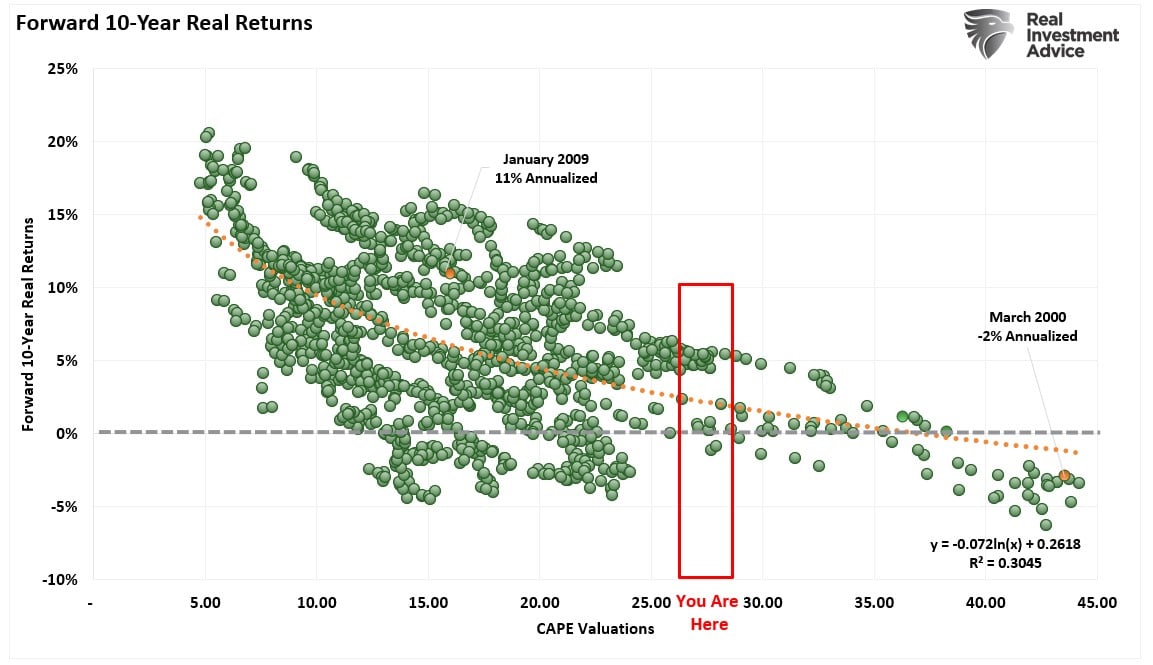
Asness continues:
“It [Shiller’s CAPE] has very restricted use for market timing (definitely by itself) and there may be nonetheless nice variability round its predictions over even a long time. However, should you don’t decrease your expectations when Shiller P/E’s are excessive with no good motive — and for my part, the critics haven’t offered motive this time round — I feel you make a mistake.”
So, if Shiller’s CAPE predicts long-term return outcomes with a protracted lag, is there probably a greater measure?
A Fly In The CAPE Ointment
As famous, valuations are a major predictor of long-term returns. Nonetheless, traders’ collapsing holding intervals of equities have created a mismatch between valuations and expectations. Moreover, intensive adjustments within the monetary system since 2008 help the argument that utilizing a 10-year common to clean earnings volatility could also be too lengthy. These adjustments embody:
Starting in 2009, FASB Rule 157 was “briefly” repealed to permit banks to “worth” illiquid belongings, resembling actual property or mortgage-backed securities, at ranges they felt had been extra acceptable quite than on the final precise “sale worth” of the same asset. This was accomplished to maintain banks solvent as they had been pressured to write down down billions of {dollars} of belongings on their books. This boosted the financial institution’s profitability and made earnings seem greater than they could have been in any other case. The ‘repeal” of Rule 157 continues to be in impact at present, and the following “mark-to-myth” accounting rule continues to be inflating earnings.
One other current distortion is the heavy use of off-balance sheet automobiles to suppress company debt and leverage ranges and enhance earnings.
In depth cost-cutting, productiveness enhancements, labor off-shoring, and so forth., are closely employed to spice up earnings in a comparatively weak income development surroundings.
A surge in company share buybacks to cut back excellent shares and enhance bottom-line earnings per share to help greater asset costs.
The final level is without doubt one of the most vital helps of upper valuations within the earlier 15 years. As famous in “Earnings Estimates Are Overly Optimistic,” buybacks have contributed to greater earnings per share regardless of lackluster development in top-line income.
A Look At The Influence Of Buybacks
Since 2009, corporate-reported earnings per share have elevated by 676%. That is the sharpest post-recession rise in reported EPS in historical past. Nonetheless, that sharp enhance in earnings didn’t come from income. (Income happens on the prime of the earnings assertion.) Income from gross sales of products and providers has solely elevated by a marginal 129% throughout the identical interval. As famous above, 75% of the earnings enhance got here from buybacks, accounting gimmicks, and price reductions.
Utilizing share buybacks to enhance underlying earnings per share contributes to the distortion of long-term valuation metrics. Because the WSJ article said in a 2012 article:
“Should you imagine a current tutorial research, one out of 5 [20%] U.S. finance chiefs have been scrambling to fiddle with their corporations’ earnings.
This could not come as a significant shock as it’s a quite “open secret.” Corporations manipulate backside line earnings by using “cookie-jar” reserves, heavy use of accruals, and different accounting devices to both flatter, or depress, earnings.
What’s extra shocking although is CFOs’ perception that these practices depart a major mark on corporations’ reported earnings and losses. When requested concerning the magnitude of the earnings misrepresentation, the research’s respondents mentioned it was round 10% of earnings per share.“
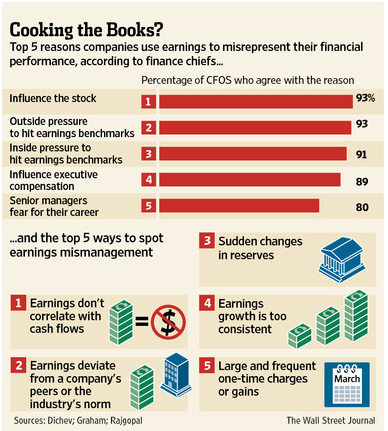
Unsurprisingly, 93% of the respondents pointed to “affect on inventory worth” and “outdoors strain” as the explanations for manipulating earnings figures. Such “manipulations” additionally suppress valuations by overstating the “E” within the CAPE ratio.
One other drawback is the period mismatch.
Period Mismatch
Give it some thought this fashion: When setting up a portfolio containing fastened earnings, one of the vital vital dangers is a “period mismatch.” For instance, assume a person buys a 20-year bond however wants the cash in 10 years. For the reason that function of proudly owning a bond is capital preservation and earnings, the period mismatch is essential. A capital loss will happen if rates of interest rise between the preliminary buy and promote date 10 years earlier than maturity.
One may moderately argue that because of the “pace of motion” within the monetary markets, a shortening of enterprise cycles, and elevated liquidity, there’s a “period mismatch” between Shiller’s 10-year CAPE and the present monetary markets.
The chart beneath exhibits the annual P/E ratio versus the inflation-adjusted (actual) .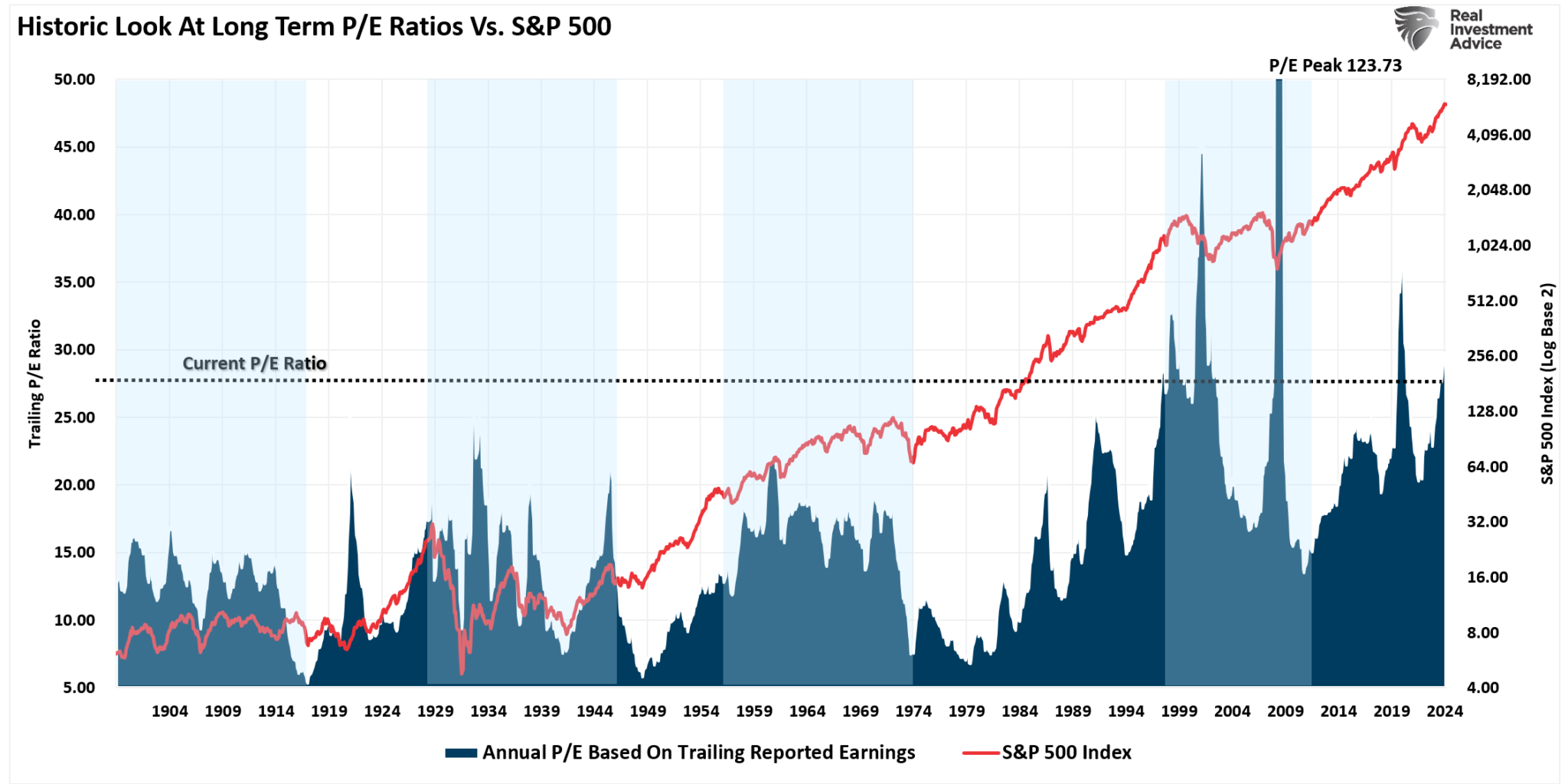
Importantly, you’ll discover that in secular bear market intervals (shaded areas), the general pattern of P/E ratios is declining. This “valuation compression” is a operate of the general enterprise cycle as “over-valuation” ranges are “imply reverted” over time. Additionally, you will discover that market costs are typically “trending sideways,” with elevated volatility throughout these intervals.
Moreover, valuation swings have vastly elevated for the reason that flip of the century, which is without doubt one of the main arguments towards Dr. Shiller’s 10-year CAPE ratio.
However is there a greater measure?
Introducing The CAPE-5 Ratio
Smoothing earnings volatility is critical to grasp the underlying pattern of valuations higher. For traders, intervals of “valuation growth” are the place the positive aspects within the monetary markets have been made during the last 125 years. Conversely, in periods of “valuation compression,” returns are way more muted and risky.
Subsequently, to compensate for the potential “period mismatch” of a faster-moving market surroundings, I recalculated the CAPE ratio utilizing a 5-year common, as proven within the chart beneath.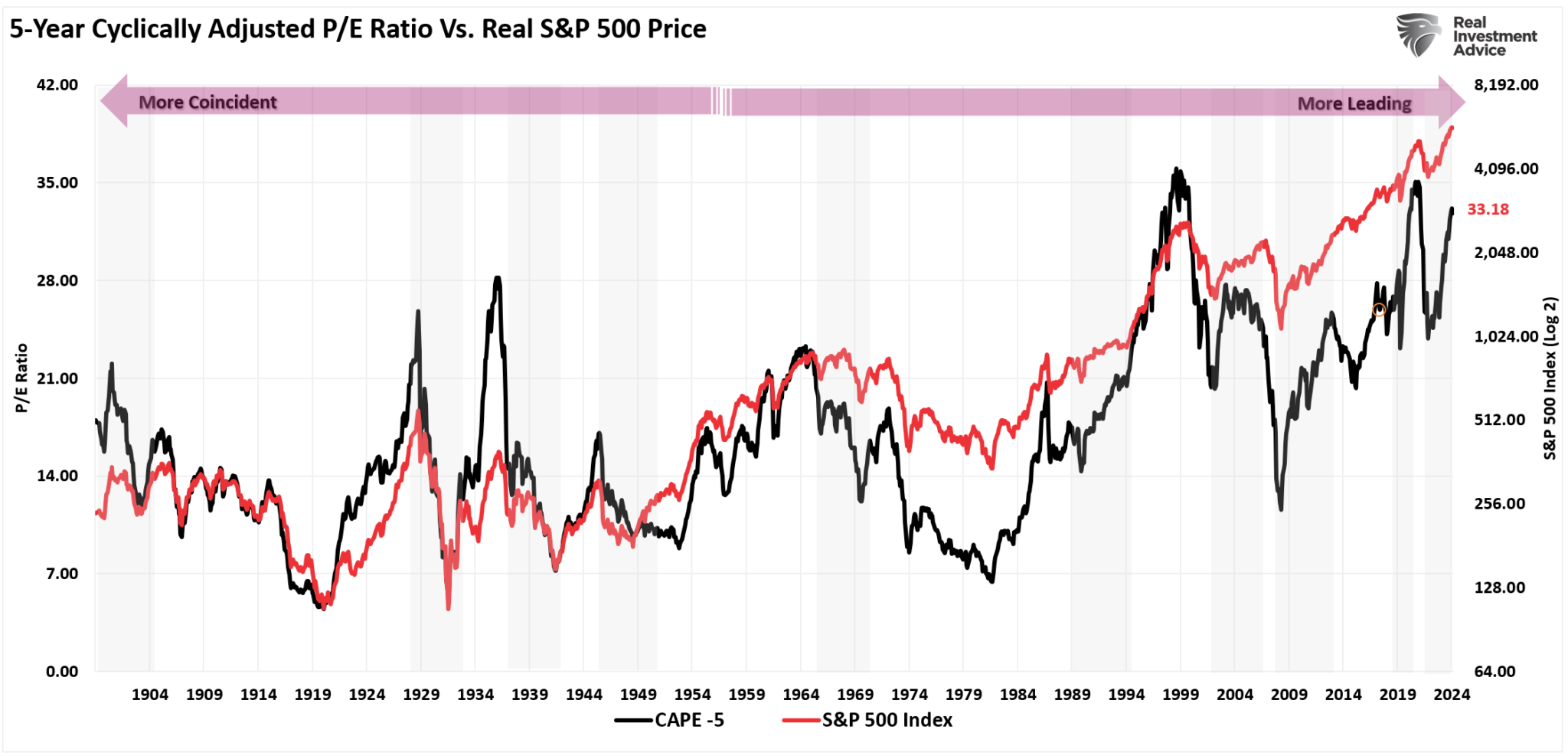
There’s a excessive correlation between the actions of the CAPE-5 and the S&P 500 index. Nonetheless, you’ll discover that earlier than 1950, the actions of valuations had been extra coincident with the general index, as worth motion was a main driver of the valuation metric. As earnings development superior way more shortly post-1950, worth motion turned much less dominating. Subsequently, the CAPE-5 ratio started to result in total worth adjustments.
Since 1950, a key “warning” for traders has been a decline within the CAPE-5 ratio, main to cost declines within the total market. The latest decline within the CAPE-5 is straight associated to the collision of inflation and the contraction in financial coverage resulting from elevated rates of interest. Nonetheless, complacency that “this time is totally different” will doubtless be misplaced when the CAPE-5 begins its subsequent reversion.
The Deviation Issues
We will have a look at the deviation between present valuation ranges and the long-term common to raised perceive the place valuations are at the moment relative to historical past. It’s essential to grasp the significance of deviation. For an “common,” valuations have to be above and beneath that “common” over historical past. These “averages” present a gravitational pull on valuations over time, which is why the additional the deviation is away from the “common,” the extra vital the eventual “imply reversion” will likely be.
The primary chart beneath is the proportion deviation of the CAPE-5 ratio from its long-term common going again to 1900.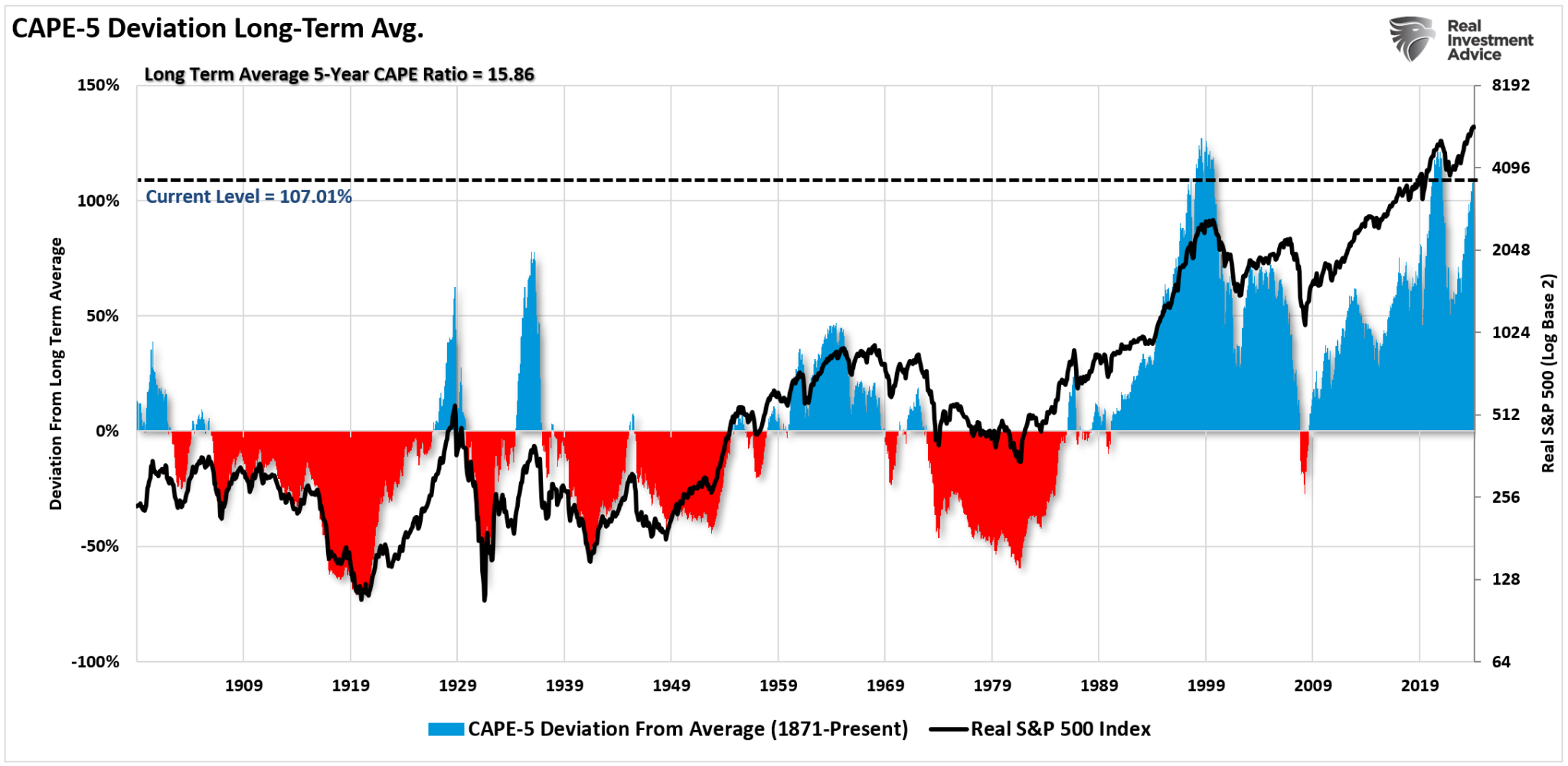
At the moment, the 107.01% deviation above the long-term CAPE-5 common of 15.86x earnings places valuations at ranges solely witnessed two (2) different instances in historical past. As said above, whereas it’s hoped “this time will likely be totally different,” which had been the precise phrases uttered in the course of the 5 earlier intervals, the eventual outcomes had been a lot much less optimum.
Nonetheless, as famous, the adjustments that occurred post-WWII relating to financial prosperity, operational capability, and productiveness warrant inspecting solely the interval from 1944 to the current.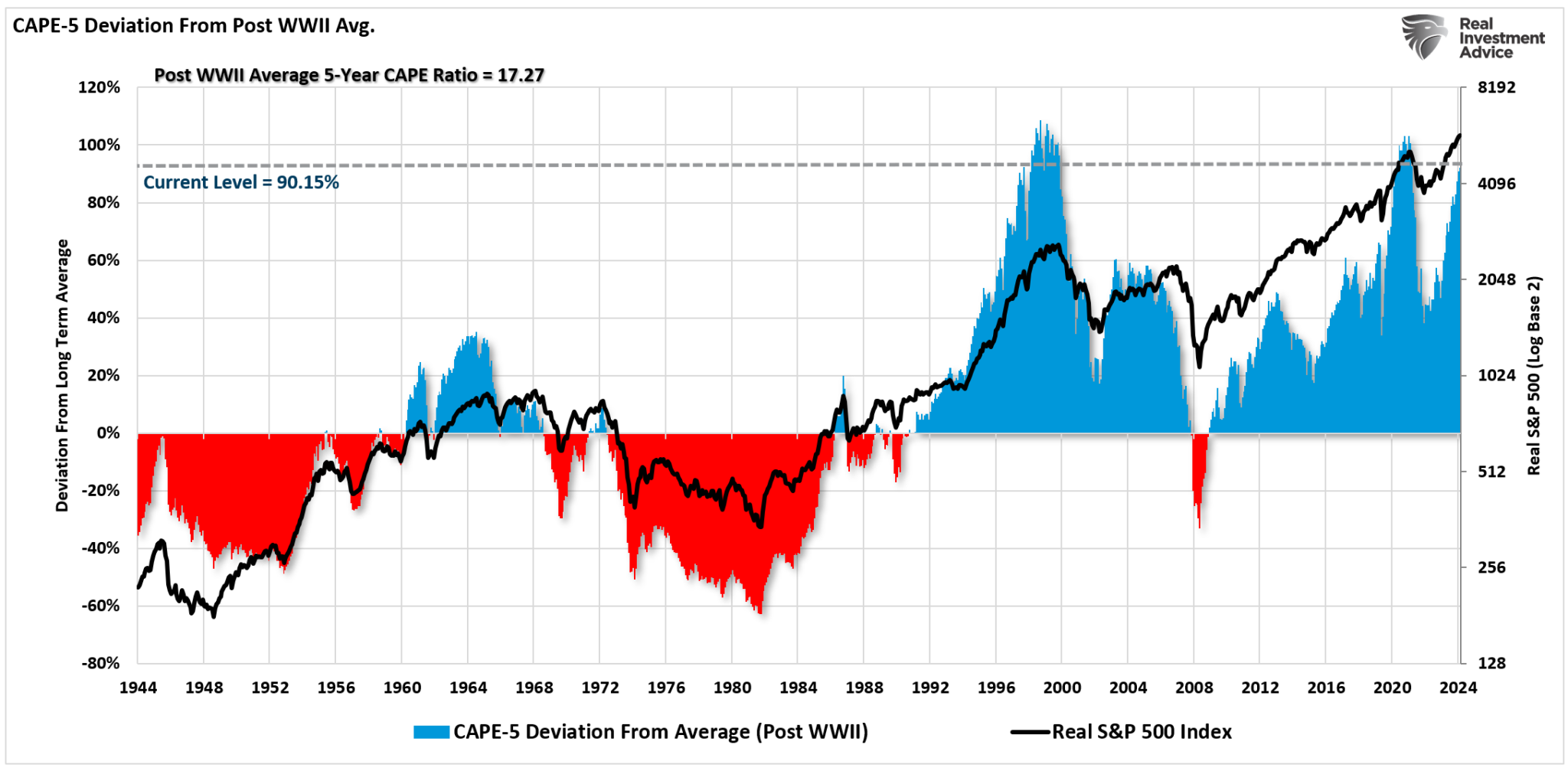
Once more, as with the long-term view above, the present deviation is 90.15% above the post-WWII CAPE-5 common of 17.27x earnings. Such a deviation degree solely occurred twice within the final 80 years: in 1996 and 2021. Once more, as with the long-term view above, the ensuing “reversion” was not sort to traders.
Conclusion
Is CAPE-5 a greater measure than Shiller’s CAPE-10 ratio? Possibly, because it adjusts extra shortly to a faster-moving market.
Nonetheless, I need to reiterate that neither Shiller’s CAPE-10 ratio nor the modified CAPE-5 ratio had been ever meant to be “market timing” indicators.
Since valuations decide ahead returns, the only function is to indicate intervals that carry exceptionally excessive ranges of funding danger and end in abysmal future returns.
At the moment, valuation measures clearly warn that future market returns will likely be considerably decrease than they’ve been over the previous 15 years. Subsequently, in case you are anticipating the markets to crank out 12% annualized returns over the following 10 years as a way to meet your retirement objectives, it’s doubtless that you can be very dissatisfied.



